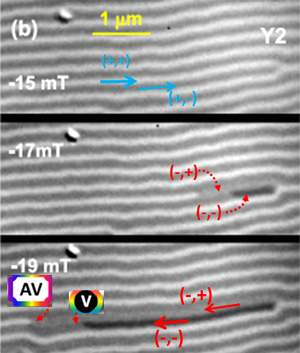Spintronics exploits the intrinsic spins of electrons and their resulting magnetic properties in materials, as well as the electrons electrical charge, to store and process information. Magnetic defects and magnetic singularities inside uniform magnetic textures are considered valid candidates for transporting information since in many cases their intrinsic characteristics, which are determined by their so-called topological properties, make them robust against external perturbations. A magnetic vortex (V) is one of the most studied singularities. It can be visualized as a typhoon in the atmosphere that can walk long distances without being perturbed by buildings or trees. In magnetism, instead of air, the magnetization is rotating. An antivortex (AV) is another singularity that if it collides with a vortex results in a mutual annihilation.
A group of researchers from the University of Oviedo, University of Porto (Portugal) together with ALBA scientists have been carrying research at the MISTRAL beamline during the last years and have recently found an interesting result concerning the correlated motion of V-AV pairs along strip magnetic domains in magnetic structures.
The magnetic structures were thin layers (50-100 nm) of magnetic materials that were displayed in equilibrium magnetic stripes as depicted in the figure below. An interesting aspect of this study is that the magnetic stripes, that act as roads for transporting V and AV, are self-organized and can be oriented at any direction or can be erased at will. As it can be seen in the lower panel, the V-AV pair moves in a correlated way for more than 3 µm which is a relatively large distance in nanomagnetic devices. In addition, the sense of motion of the V-AV pair (towards right or left) is completely determined by the topology of the bifurcation.
The finding is a robust effect that might have practical applications as this V-AV motion could increase the efficiency in controlling magnetic memory and logic devices.
|
|
Fig: As it can be seen in the upper panel, there are white and grey lines rather parallel which correspond to different magnetizations as indicated by the arrows [ (+,+) indicates positive in-plane and perpendicular magnetizations respectively]. At the right side there is a bifurcation indicated as Y2. When a magnetic field pointing to the left of the figure of the appropriate magnitude is applied, the magnetization inverts as indicated in the central panel: (+,+) changes to (-,+) and (+,-) to (-,-). Magnetic calculations that reproduce very well the magnetic images indicate that the magnetic inversion occurs via the generation of V-AV pairs generated at the bifurcation Y2. In the central panel the end of the black (-,-) stripe gives the location of the vortex and the end of the grey (-,+) line is that of the AV. |
Reference: A. Hierro-Rodriguez et al. Appl. Phys. Lett. 110, 262402 (2017); doi: 10.1063/1.4984898





